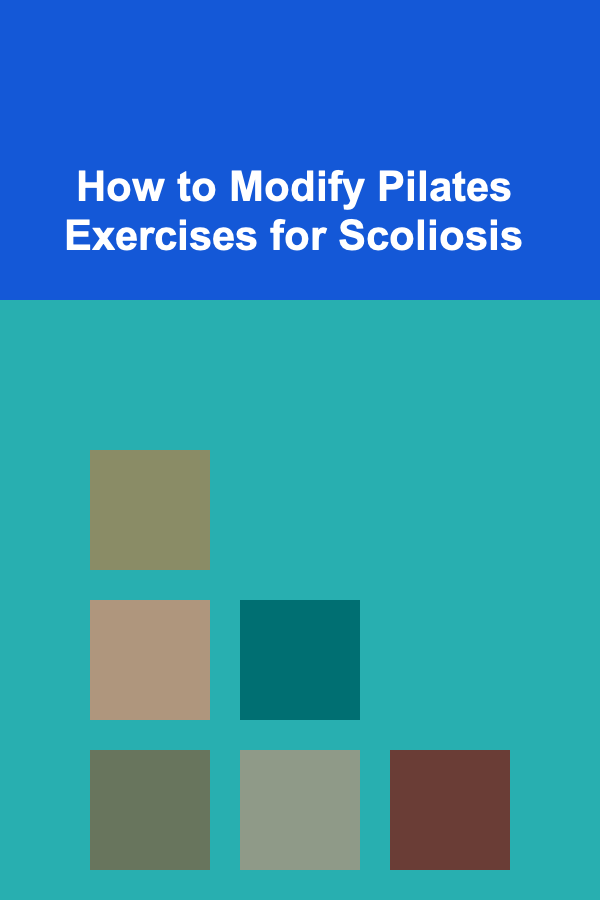
How to Modify Pilates Exercises for Scoliosis
ebook include PDF & Audio bundle (Micro Guide)
$12.99$8.99
Limited Time Offer! Order within the next:

Scoliosis is a condition that involves an abnormal curvature of the spine, often creating a side-to-side curve that can affect posture, flexibility, and overall mobility. Individuals with scoliosis often face challenges in physical activities, particularly those involving spinal alignment and balance, such as Pilates. However, Pilates can be an incredibly beneficial exercise regimen for individuals with scoliosis if appropriately modified to accommodate their specific needs.
Pilates focuses on core strength, flexibility, posture, and body awareness---key elements that can help improve spinal health and mitigate discomfort caused by scoliosis. But because each scoliosis case is unique, it's essential to tailor Pilates exercises to the specific curvature and severity of the individual's condition. In this article, we will explore how to modify Pilates exercises to benefit people with scoliosis, ensuring that they can perform these exercises safely and effectively.
Understanding Scoliosis and Its Impact on the Body
Before we dive into how to modify Pilates exercises, it's important to understand the basic mechanics of scoliosis and how it affects the body. Scoliosis typically presents as a sideways curvature of the spine, often forming an "S" or "C" shape rather than the natural, straight alignment of the spine. This curvature may vary in severity, and in some cases, it can lead to muscle imbalances, pain, and reduced range of motion.
The causes of scoliosis can range from congenital factors (present at birth) to idiopathic (unknown) causes, and it can be classified into several types based on its characteristics:
- Idiopathic Scoliosis: This is the most common type, especially among adolescents, and the cause is unknown.
- Congenital Scoliosis: This type is present at birth and occurs due to spinal malformations.
- Neuromuscular Scoliosis: This type results from conditions such as cerebral palsy or muscular dystrophy, which affect muscle function and spinal alignment.
People with scoliosis may experience symptoms like back pain, muscle fatigue, uneven shoulders or hips, and difficulty with activities that require balance or alignment. Depending on the severity, scoliosis can impact a person's ability to engage in certain physical activities. Pilates, however, can be an excellent way to address these challenges and enhance overall spinal health, provided the exercises are modified accordingly.
Key Considerations for Modifying Pilates for Scoliosis
Before starting Pilates exercises, it's essential to consider the following factors that can influence how exercises should be adjusted for individuals with scoliosis:
1. Spinal Curvature Type and Severity
The first factor to consider is the type and severity of the spinal curvature. Some people may have a mild curve, while others may have a more pronounced one. The specific curvature type, whether it's a right- or left-sided curve, as well as the location of the curve (thoracic or lumbar), can all influence how exercises are performed.
- C-curve scoliosis: This involves a single curve that creates a "C" shape in the spine.
- S-curve scoliosis: This type has two curves, one in the thoracic spine and another in the lumbar region, forming an "S" shape.
2. Compensation and Muscle Imbalances
Scoliosis often leads to muscle imbalances, as the body may compensate for the curvature by shifting weight or using certain muscles more than others. For instance, muscles on one side of the body may become overactive, while muscles on the other side become underactive. Pilates can help address these imbalances by focusing on strengthening weak muscles and stretching tight ones.
3. Posture and Alignment
Individuals with scoliosis often have an altered posture due to the curvature. They may have uneven shoulders, hips, or a shifted pelvis. Pilates exercises need to be adjusted to ensure that proper alignment is maintained and that the exercises do not exacerbate these postural issues.
4. Pain and Discomfort
Some individuals with scoliosis experience pain or discomfort, particularly after long periods of standing, sitting, or certain movements. When modifying Pilates exercises, it's crucial to ensure that movements do not cause strain or discomfort. A focus on gentle stretching, controlled movements, and slow progressions is essential.
How to Modify Pilates Exercises for Scoliosis
Pilates offers a wide variety of exercises that target core strength, flexibility, and spinal mobility---all of which can benefit individuals with scoliosis. However, modifications are often necessary to ensure safety and effectiveness. Below are some key modifications for common Pilates exercises, along with considerations for individuals with scoliosis.
1. The Pelvic Curl
Modification for Scoliosis: The pelvic curl is a fundamental Pilates exercise that engages the core and promotes spinal articulation. For individuals with scoliosis, it's important to adjust the starting position and movement to accommodate spinal curvatures.
- For C-curve Scoliosis: If the curve is to the right, begin the pelvic curl by focusing on engaging the muscles of the left side of the body first. This helps to balance out the curve and prevent overcompensation on one side.
- For S-curve Scoliosis: If the curve is pronounced in both the thoracic and lumbar regions, modify the pelvic curl by focusing on symmetrical engagement through both sides of the body. It might be helpful to start with a more neutral spine position before progressing into the curl.
Focus Areas:
- Keep the pelvis level throughout the movement.
- Focus on using your core muscles to lift your spine vertebra by vertebra, ensuring each section of the spine is engaged.
- Avoid any excessive arching or twisting of the spine.
2. The Cat-Cow Stretch
Modification for Scoliosis: The Cat-Cow stretch is often used to mobilize the spine and stretch the back. For people with scoliosis, the movement can be adjusted to avoid overextending the spine, especially in the direction of the curve.
- For C-curve Scoliosis: Begin the Cat-Cow stretch with a gentle rounding of the spine, focusing on the side of the body opposite the curve. This helps to create space and flexibility in the areas that may be tight due to the scoliosis.
- For S-curve Scoliosis: Focus on keeping the spine in a neutral position as much as possible. Allow for gentle flexion and extension, but avoid overextending in one direction.
Focus Areas:
- Maintain a fluid motion as you alternate between rounding and arching your back.
- Keep the pelvis stable throughout the movement.
3. The Spine Twist
Modification for Scoliosis: The Spine Twist is an excellent exercise for improving mobility in the thoracic spine, which is often affected by scoliosis. When modifying this exercise, it's essential to ensure that the twist is done gently and without overexerting the body.
- For C-curve Scoliosis: Focus on twisting the spine toward the side opposite the curvature to promote balance and open up the stiff side. Avoid twisting too far toward the curved side, as this could exacerbate muscle imbalances.
- For S-curve Scoliosis: Start with a mild twist and focus on the movement coming from the thoracic spine rather than forcing movement through the lumbar spine. The goal is to encourage mobility without straining the body.
Focus Areas:
- Keep the core engaged throughout the movement.
- Maintain the pelvis and hips stable, allowing the upper body to rotate.
- Perform the twist slowly to ensure controlled movement.
4. The Saw
Modification for Scoliosis: The Saw is a great exercise for improving spinal flexibility and posture, particularly in the thoracic spine. However, for individuals with scoliosis, it is important to modify the movement to avoid over-twisting or straining the spine.
- For C-curve Scoliosis: Start by twisting toward the side of the spine that is less affected by the curve. This ensures that the twist is more balanced and reduces any excessive tension on the curved side.
- For S-curve Scoliosis: Focus on ensuring the pelvis stays level as you twist. Avoid letting one hip lift higher than the other, as this can exacerbate postural imbalances.
Focus Areas:
- Keep the spine long and the core engaged.
- Use the arms to guide the twist, but don't force it.
5. The Swimming Exercise
Modification for Scoliosis: The Swimming exercise strengthens the back and core muscles, which are crucial for improving posture and spinal stability. For scoliosis, modifications may be necessary to ensure proper alignment and avoid strain on the spine.
- For C-curve Scoliosis: Engage the side of the body opposite the curve as you lift the arms and legs. This will help promote symmetry and prevent one side from being overworked.
- For S-curve Scoliosis: Focus on keeping the pelvis stable and avoid excessive rotation of the spine. The movement should remain controlled and fluid.
Focus Areas:
- Keep the arms and legs extended and engaged.
- Maintain a long neck and avoid arching the lower back too much.
6. Side-Lying Leg Work
Modification for Scoliosis: Side-lying leg exercises are excellent for targeting the hip muscles and improving lateral strength. For people with scoliosis, side-lying exercises can be beneficial for addressing muscle imbalances, particularly in the lower back and hips.
- For C-curve Scoliosis: Perform side-lying leg exercises with the curved side of the spine facing upward. This helps to alleviate tension on the side of the body with the curve and engages the muscles on the opposite side.
- For S-curve Scoliosis: Perform side-lying exercises with an emphasis on keeping the pelvis level and aligned with the spine. Focus on slow, controlled movements to avoid unnecessary strain on the back.
Focus Areas:
- Engage the core to stabilize the pelvis.
- Avoid lifting the leg too high, which could cause discomfort in the lower back.
Conclusion
Pilates can be an incredibly beneficial exercise practice for individuals with scoliosis, helping to strengthen muscles, improve posture, and increase flexibility. However, due to the nature of scoliosis, it's essential to modify exercises to ensure safety, balance, and effectiveness. By understanding the specific needs of the individual and adjusting exercises accordingly, Pilates can be a powerful tool in managing scoliosis and improving overall spinal health.
Remember, when modifying Pilates exercises for scoliosis, it's crucial to focus on alignment, breath, and control, while also being mindful of the individual's unique curvature and pain levels. Consulting with a qualified Pilates instructor who is familiar with scoliosis is highly recommended to ensure that exercises are performed safely and correctly.
With consistent practice and careful modification, Pilates can help individuals with scoliosis build strength, reduce discomfort, and achieve better spinal health.
Reading More From Our Other Websites
- [Personal Financial Planning 101] How to Prepare Financially for Parenthood
- [Gardening 101] Japanese Garden Design: A Step-by-Step Guide to Serenity
- [Personal Investment 101] How to Use Robo-Advisors for Ethical and Impact Investing
- [Organization Tip 101] How to Prepare Healthy Breakfast Options for the Week
- [Gardening 101] Essential Tips for Growing an Indoor Garden Year-Round
- [Home Renovating 101] How to Incorporate Kitchen Appliance Trends: Budget-Friendly Ways to Upgrade Your Cooking Space
- [Organization Tip 101] How to Incorporate Inspirational Quotes into Your Music Room
- [Personal Finance Management 101] How to Manage Your Finances While Going Through a Divorce
- [Organization Tip 101] Benefits of Upgrading to a Modern Chimney Cap
- [Personal Financial Planning 101] How to Deal with Debt Collectors and Protect Your Financial Rights

How to Sell Your Antique Books Through an Online Marketplace
Read More
Human Rights: Advocating for Dignity and Freedom for All
Read More
The Financial Advisor's Toolkit: Essential Skills for Managing Wealth and Growth
Read More
Using Social Media Wisely During Your Job Search
Read More
How to Master Perspective in Illustration
Read More
How to Plan a Foreign Film Movie Night
Read MoreOther Products

How to Sell Your Antique Books Through an Online Marketplace
Read More
Human Rights: Advocating for Dignity and Freedom for All
Read More
The Financial Advisor's Toolkit: Essential Skills for Managing Wealth and Growth
Read More
Using Social Media Wisely During Your Job Search
Read More
How to Master Perspective in Illustration
Read More